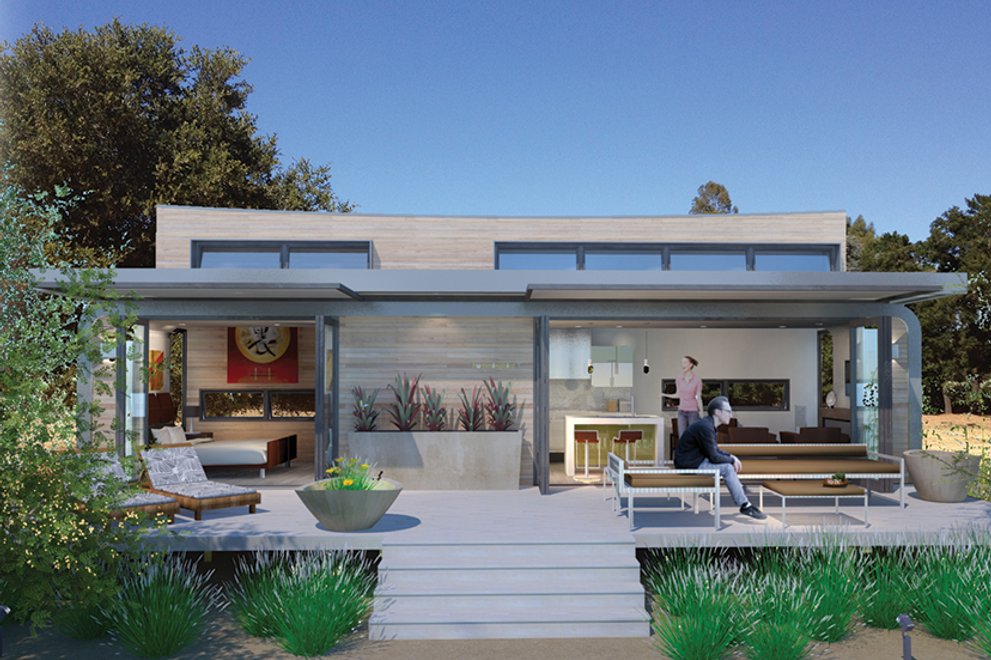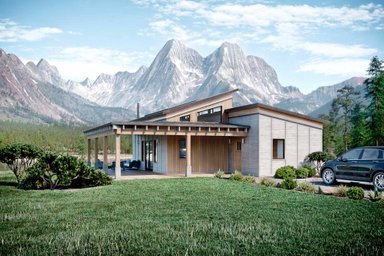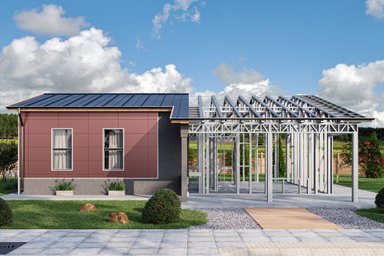Tips for Building an Energy-Efficient Home
Don’t wait until you’re shopping for appliances to think about energy efficiency—make it a priority from the start.
To build your energy-efficient, dream green home, you need to know where to begin.
Orientation
David Johnston, president of the Boulder, Colorado-based green building/sustainable development consulting firm What’s Working, recommends beginning with the orientation of your home on the land. “Orientation and south facing windows can determine as much as half the cost of heating a home,” Johnston says. “Once the house is sited, framed and insulated, it is hard—or expensive—to go back.” Orientation (an aspect of passive solar design) is determined by sun angles and includes sizing south facing windows in accordance with the size of the home. Optimal sun angles are southeast on winter mornings and southwest on winter afternoons. “Breakfast nooks and kitchens are best facing the warm southeast summer sun,” Johnston says. Living areas on the south side are cheerful in the daytime, and bedrooms on the north side can buffer the house from winter cold.
Take Advantage of Thermal Mass
Another principle of passive solar design that makes houses more energy efficient is thermal mass storage in which masonry walls and thick tile or cement floors illuminated by sunlight during the day store that heat and release it into the house at night. Tucson, Arizona-based green builder and solar pioneer John Wesley Miller employs this concept to build highly energy-efficient solar homes in the Armory Park del Sol community of southeast Tucson, which includes one of the first zero-energy homes in the country.
While Miller’s territorial, Mission Revival, and bungalow-style homes blend into this turn-of-the century, revitalized inner-city neighborhood, the houses also feature state-of-the-art solar systems and 8-inch-thick, concrete-filled exterior block walls wrapped in rigid foil-faced polyisocyanurate (a thermoset plastic) board covered with stucco. “What makes solar work better is minimizing your need for it in the first place,” Miller says. The more energy efficient your house is (by utilizing principles like thermal mass storage), the less energy you have to use (from PV or the grid) to heat and cool it.
Insulate, Insulate, Insulate
According to Johnston, insulation is the second most important decision you have to make. It determines the type of framing used, the wall thickness, and many of the trim options around your windows and doors. He suggests including 50 percent more insulation than local code requires. “Builders will try to talk you out of going above code,” he says. “Don’t listen to them. Insulation is the best investment you can make, and it will yield a higher return every year you live in your home than most other investments.”
Don’t wait until you’re shopping for appliances to think about energy efficiency—make it a priority from the start.
To build your energy-efficient, dream green home, you need to know where to begin.
Orientation
David Johnston, president of the Boulder, Colorado-based green building/sustainable development consulting firm What’s Working, recommends beginning with the orientation of your home on the land. “Orientation and south facing windows can determine as much as half the cost of heating a home,” Johnston says. “Once the house is sited, framed and insulated, it is hard—or expensive—to go back.” Orientation (an aspect of passive solar design) is determined by sun angles and includes sizing south facing windows in accordance with the size of the home. Optimal sun angles are southeast on winter mornings and southwest on winter afternoons. “Breakfast nooks and kitchens are best facing the warm southeast summer sun,” Johnston says. Living areas on the south side are cheerful in the daytime, and bedrooms on the north side can buffer the house from winter cold.
Take Advantage of Thermal Mass
Another principle of passive solar design that makes houses more energy efficient is thermal mass storage in which masonry walls and thick tile or cement floors illuminated by sunlight during the day store that heat and release it into the house at night. Tucson, Arizona-based green builder and solar pioneer John Wesley Miller employs this concept to build highly energy-efficient solar homes in the Armory Park del Sol community of southeast Tucson, which includes one of the first zero-energy homes in the country.
While Miller’s territorial, Mission Revival, and bungalow-style homes blend into this turn-of-the century, revitalized inner-city neighborhood, the houses also feature state-of-the-art solar systems and 8-inch-thick, concrete-filled exterior block walls wrapped in rigid foil-faced polyisocyanurate (a thermoset plastic) board covered with stucco. “What makes solar work better is minimizing your need for it in the first place,” Miller says. The more energy efficient your house is (by utilizing principles like thermal mass storage), the less energy you have to use (from PV or the grid) to heat and cool it.
Insulate, Insulate, Insulate
According to Johnston, insulation is the second most important decision you have to make. It determines the type of framing used, the wall thickness, and many of the trim options around your windows and doors. He suggests including 50 percent more insulation than local code requires. “Builders will try to talk you out of going above code,” he says. “Don’t listen to them. Insulation is the best investment you can make, and it will yield a higher return every year you live in your home than most other investments.”






